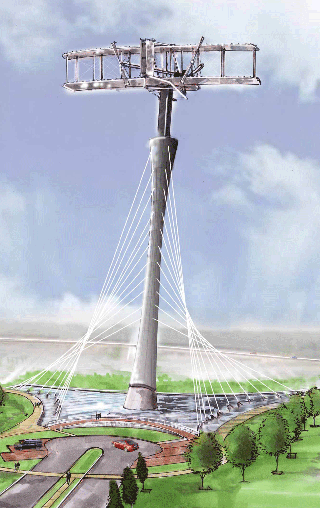 Within three years a group in Dayton, Ohio, could start work on a 25-story monument at the north end of Dayton with a replica of a 1905 Wright Flyer atop it. Since the wingspan will be 144 feet, engineers want to make sure the heavy stainless steel model doesn’t go on an untethered flight before crashing to the ground at the junction of interstates 70 and 75. That’s where Ohio State University students come in.
Within three years a group in Dayton, Ohio, could start work on a 25-story monument at the north end of Dayton with a replica of a 1905 Wright Flyer atop it. Since the wingspan will be 144 feet, engineers want to make sure the heavy stainless steel model doesn’t go on an untethered flight before crashing to the ground at the junction of interstates 70 and 75. That’s where Ohio State University students come in.
The project is promoted by the Wright Image Group that must raise $12 million for the project. Walter Ohlman, president of the group, said it now has $1 million plus the land for the memorial that will become the icon of the city, much like the Gateway Arch at St. Louis. Since it is near the airport, the group also has permission of the FAA and the airport, and since it is near two busy interstate highways, it has the approval of the Ohio State Patrol.
Engineering students at Ohio State University have completed analysis of aerodynamic forces that could exert tons of force on the wings of the Wright Flyer. Aerospace engineering seniors Lindsey Crump, Chelsea Curtin, Tim Hendrickson, and Mitch Le completed the project with technical guidance by their faculty advisor, Professor Mike Benzakein, and NASA Glenn Research Center engineer Tom Benson, and Chuck Stevens of Stevens Aircraft Engineering. The project is included in their graduation credits. Stevens said he is confident the monument can be engineered to withstand whatever forces the wind might put on the model.
 The students started the project at the beginning of the 2012 autumn semester. They built on earlier work done by the University of Dayton and used computer models and the Ohio State University’s 3-by-5-foot wind tunnel to estimate the forces generated by wind velocities up to 220 mph. A final number for the amount of force on the model has not been calculated. The wingspan is 120 feet, the exact distance of the Wright’s first flight.
The students started the project at the beginning of the 2012 autumn semester. They built on earlier work done by the University of Dayton and used computer models and the Ohio State University’s 3-by-5-foot wind tunnel to estimate the forces generated by wind velocities up to 220 mph. A final number for the amount of force on the model has not been calculated. The wingspan is 120 feet, the exact distance of the Wright’s first flight.
The 1905 Flyer is the one that flew on Huffman Prairie for about 39 minutes, which marked the conclusion of the Wright brothers' early experiments and the beginning of their efforts to commercialize their invention. The original, restored 1905 Flyer is on display at Carillon Historical Park in Dayton and a unit of the Dayton Aviation Heritage National Historical Park.
The Wright Image Group has a technical liaison with NASA Glenn and will use the Ohio State University analysis to identify the need for further testing with larger scale models and wind tunnels, possibly at Glenn Research Center.



